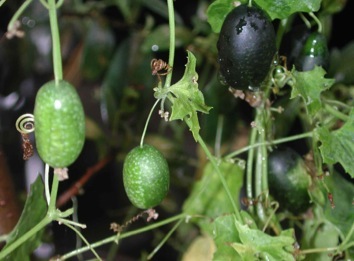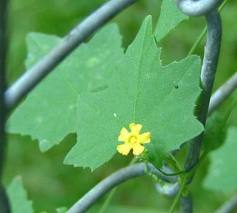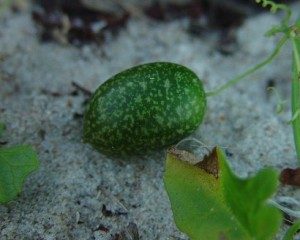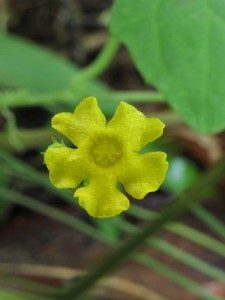Cute Cuke! Melothria Pendula
The Melothria pendula is a little cucumber with a big reputation.
That said, when it comes to the “creeping cucumber” I’m not sure you can trust botanists who never get out of the college classroom, or Internet experts who’ve never eaten a wild plant. It is one thing to copy, it is another to consume.
If you search the web for Melothria pendula (Mel-OTH-ree-uh PEND-you-luh) you will find two contradicting comments, that it’s edible and that it’s toxic. The state of North Carolina calls it mildly toxic, the state of Florida does not, one person says it is harmless, the other say it is harmful. Actually what they say in their own way is that at some point the Melothria pendula becomes the Mother of all Laxatives.
All I can say is I’ve eaten a lot of light to medium green M. pendula at a time with no apparent harm and have known others to eat them as well. Many people put them in salads as they would cherry tomatoes. So where does the problem lie? Probably with the ripening fruit, or the one and only historical account was wrong. The little cukes turn black as they ripen and that’s probably a good sign to leave them alone. But green it’s salad here we come. The state of North Carolina adds its toxicity is low even if purgative.
Professor Julia Morton, in the fifth edition of her book “Wild Plants for Survival in South Florida” says: “… the unripe fruit resembling miniature watermelons, are certainly eaten by children in South Florida with no apparent harm. F.P.Porcher in 1863 referred to the seeds as ‘drastically purgative’; no evidence of that has come to hand to support that. In the West Indies and Central America, the fruits of M. guadalupensis are eaten ripe and pickled unripe.”
In the 2002 edition of the academic journal Ciencia Ego Sum, authors Amaury M. Arzate-Fernández and Graciela Noemí Grenón-Cascales, investigated growing the M. pendula up to 8,500 feet. Translated from the Spanish, with thanks from my friend, Manuel Mora-Valls, they say:
“Melothria pendula L. has been mentioned as a wild species of the Cucurbitaceae family in Mexico that continues without being studied to its full extend (Lira et al., 1998). The necessity of proteins, for man as well as for the livestock, is of high priority, and for this reason that the production of plants as source of amino acids is researched.
According to the “chemical-bromatologic” analysis of this plant carried out in the present work, this vegetal species under study constitutes a source of water, vitamins, minerals and, amazingly, also proteins. The fruits of this plant, despite its reduced size, has a pleasant sweet flavor and are edible for humans. Besides, its foliage is given to livestock as forage. For this reason, this “wild cucumber” could be an additional nutritional alternative for men and animals.”
They say it is 12.6% protein, 16.30% fiber and 56.8% carbohydrates. They also say the entire plant is good for ruminants. Propagation is by seed and cuttings. Not bad for a plant the Tarheel state lists as toxic. What I would like to know is whether the leaves cooked are fit for human consumption. I’ll have to find out some day.
There is also a lot of misinformation about what the plant’s name means. There isn’t much of a problem with “pendula” which means suspended, and indeed the little fruits hang on stems off the vine. Melothria is another issue. Carl Linnaeus, who invented Dead Latin names for plants, was the first to call the creeping cucumber Melothria pendulabecause it was similar in description to a plant of the same name referred to by ancient Greeks .Most contemporary references, which just copy each other, usually say the meaning of “melothria” is unknown but refers to a classical vine that may have been in the gourd family, the Bryonia Cretica. However, that’s not quite accurate. Melothria comes from the Greek word Melothron, which in ancient Greek meant “an apple” and where we get the word “melon” in English. Milo still means apple in modern Greek. Thus the meaning of “melothria” is not at all unknown. It means apple, or little apple, but which plant it referred to is an educated guess.Both Theophrastes and Dioscorides referred to a particular plant as the Melothria, and it might have been, as mentioned earlier, the Bryonia Cretica. B. Cretica is a little round gourd that looks very much like a tiny green apple that turns red when ripe. Calling it a “little apple” makes a lot of sense because it turns red. And, it definitely has toxic properties but is also edible in some ways. Yet here is where the academics always confound me: They say Theophrastes and Dioscorides might have been talking about a white grape rather than the red Bryonia Cretica.Let’s ponder for a moment… these Greeks called one of two plants a little apple. One of the plants has a small, round green gourd that turns bright red. The other plant is a grape that goes from green to whitish. So let’s ask ourselves the question: Would two botanical Greeks call a white grape a little red apple? I don’t think so. Where do academics get these ideas? Not in Greek class!The fruit of the M. pendula is only about one to two centimeters long and looks like a perfect, smooth, miniature watermelon. But, it has a definite “cucumber” aroma and taste, some times a slightly tart cucumber taste. They are crisp when light green, but grow mushy when dark green — like an overripe cucumber — and not at all pleasant when black. I suspect that if the seeds are purgative it is when they’re mature, which is what happens to another gourd, the Momordica charantia. M. Charantia is edible when green and cooked but quite toxic and not edible when ripe. To learn more about the M. charantia .
Another little cuke that is close in size and use to the M. pendula but with no reports of laxative issues when ripe is Melothria scabra, or the Mexican Gherkin or Mexican Sour Gherkin. Its seeds can be ordered from a variety of seed-sellers online.
M. pendula (also called the Guadeloupe cucumber) is a perennial vine with leaves that are palmately lobed — like a hand with pointed tips. The largest leaves, near the base of the plant, are about 2-inches long. The leaves grow smaller towards the tip of the vine. Like other members in the family, it has curly tendrils to grab other plants for support. The vines can reach many feet long and form mats or spiderweb-like drapes. The flowers are yellow and very small with five petals. Its preferred habitat is along the edges of marshes, sandy roadsides, low woods, parking lot shrubs, and almost any fence.
M. pendula is found from Pennsylvania to Florida, west to Texas and Nebraska, and throughout the world. Other scientific names include: Melothria nigra, Melothria nashii, Melothria microcarpa, Melothria guadalupensis, Melothria fluminensis, and Melothria edulis.
Green Deane’s “Itemized” Plant Profile
IDENTIFICATION: Vine with slender, climbing stems and curled tendrils. Leaves dark green, three to five lobes, 1.5 to 3 inches, resembles English Ivy but more delicate. Flowers, small, yellow, five petaled, notched at the end. Fruit looks like doll-size watermelon, green and mottled or lightly speckled when unripe, black when ripe, filled with juicy pulp and whitish seeds.
TIME OF YEAR: In northern climes in fruit in summer, like a cucumber. In southern areas it can fruit all year if no frost.
ENVIRONMENT: They grow from moist to occasionally watered spots, often found draping on shrubs.
METHOD OF PREPARATION: Young light green melon can be eaten out of hand or added to salads for a cucumber flavor and aroma. They can be pickled. Remember, do not eat dark green or black fruit. Otherwise they are a nice nibble.





![DSCN0050[2]](https://www.eattheweeds.com/wp-content/uploads/2017/09/DSCN00502-300x225.jpg)
